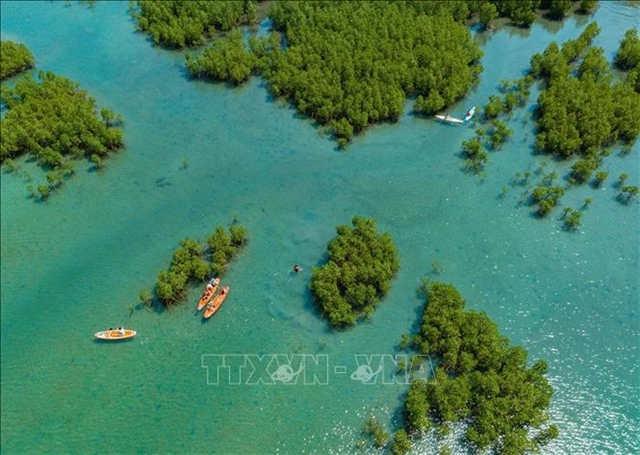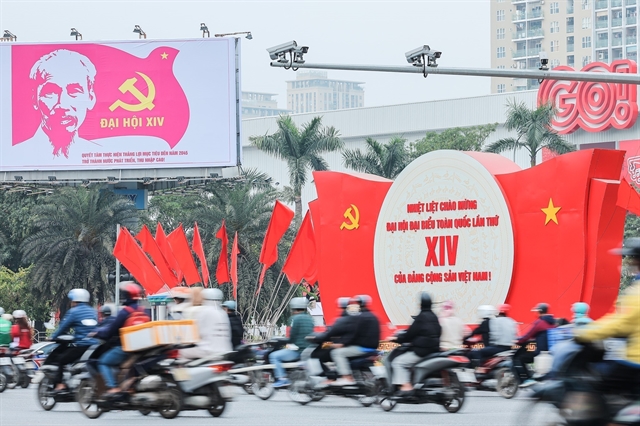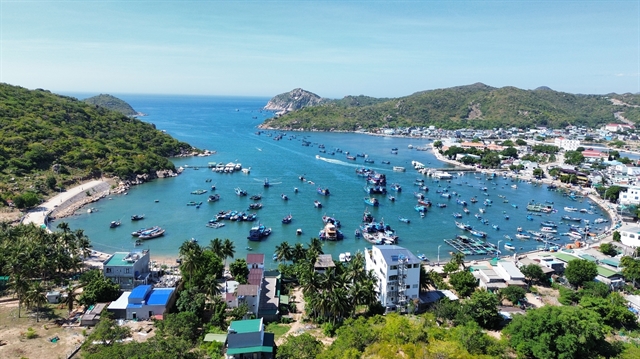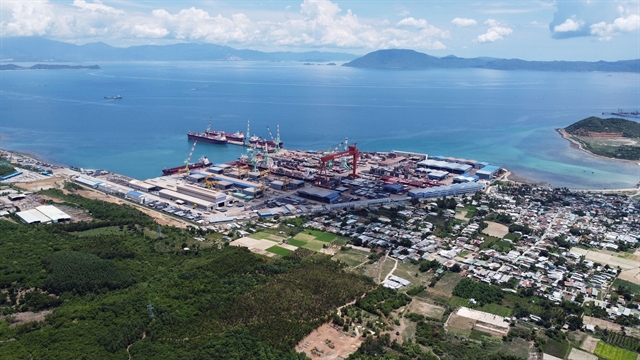 Life & Style
Life & Style

 |
| Vĩnh Hy Bay, within the Núi Chúa World Biosphere Reserve in Ninh Thuận Province. VNA/VNS Photo Nguyễn Thành |
The maritime space of Việt Nam is renowned for its richness in natural resources as well as its significant economic, geopolitical, defence and security positions, both regionally and globally.
However, alongside these advantages, Việt Nam's seas and islands are facing a multitude of issues such as degradation of landscapes and marine and coastal ecosystems, coastal marine pollution and the increasing impacts of natural disasters, climate change and rising sea levels; while the level of public awareness in exploiting sea resources remains limited.
With the understanding that marine space is finite, a planned approach to marine space use is becoming essential and the National Marine Spatial Planning will be the blueprint that guides the exploitation of marine resources and islands in a sustainable manner, balancing economic and social development with national defence and security.
Việt Nam has a coastline stretching over 3,260km. The population of 28 coastal provinces and cities (out of 63 total) accounts for more than 50 per cent of the country's total population, with most of the workforce engaged in marine-related industries. The 28 localities contribute about half of the nation's GDP, with average income higher than the national average.
The country has significant potential in terms of marine economy, such as maritime transportation, mineral extraction and processing, seafood harvesting, aquaculture and processing, and sea tourism.
Among the 11,000 species occupying the 20 typical ecosystems in six different marine biodiversity zones, 1,700 aquatic seafood species have been acknowledged, including 130 with high economic value. The estimated sustainable catch potential from fishing in Vietnamese waters is over 2.83 million tonnes per year.
Currently, 18 out of 19 coastal economic zones nationwide have been established according to the plan. These zones have attracted 553 foreign projects with a total registered investment capital of US$54.36 billion and 1,604 domestic projects with a total registered capital of VNĐ1.37 trillion (US$53.9 million).
Recognising the crucial role and importance of the seas and islands in the nation's development, the 8th plenum of the 12th tenure Party Central Committee of the Communist Party of Việt Nam in October 2018 issued a Strategy for Sustainable Development of Việt Nam's Marine Economy until 2030, with a vision to 2045. The goal is to turn Việt Nam into a strong maritime nation and set standards for sustainable marine economic development.
To firm up the perspectives, objectives and policies stated in the Party Resolution, the Government assigned the Ministry of Natural Resources and Environment to take the lead in the planning documents.
This will be presented to the National Assembly at the seventh plenary session, to be resumed next week.
 |
| The Vân Phong Economic Zone covers an area of approximately 150,000ha, with around 80,000ha of water and about 70,000ha of land and islands. VNA/VNS Photo Huy Hùng |
Nguyễn Chu Hồi, a deputy of the current National Assembly and former deputy general director of the Việt Nam Administration of Seas and Islands, said this plan was urgently needed to maximise the potential and advantages of Việt Nam's seas and respond to both immediate and long-term challenges, while also considering construction and defence.
The environment ministry has coordinated with various ministries, central agencies, universities and research institutions, experts as well as coastal provinces and cities to investigate, survey the current status and needs of marine space use and supplement information and data to put together the plan.
According to environment Minister Đặng Quốc Khánh, this is a challenging and complex task, undertaken for the first time in Việt Nam, the plan needs to be multi-level, "dynamic and open, guiding and integrated".
The vision for 2050 aims to complete the allocation of marine space to effectively manage and utilise it, in line with the country's development needs based on natural, socio-economic, environmental and marine and island ecosystem conditions, ensuring the effective use of marine and island resources, balancing sustainable marine economic development goals, the Millennium Development Goals concerning the seas, culture, national defence and security; ensuring the balance of natural ecosystems; meeting the goals of comprehensive, synchronised innovation, industrialisation and modernisation; and achieving the goal of making Việt Nam a strong and prosperous maritime nation.
Ensuring sustainable development
The goal of the marine spatial planning – the distinction that sets it apart from sectoral plans – is its focus on resolving conflicts in the three-dimensional space by various sectors in specific marine areas, while enhancing compatibility in the activities of marine resource and environmental usage.
Marine spatial planning will support integrated and unified state management of the seas, based on a spatial approach, particularly for coastal and offshore areas that are subject to large-scale exploitation and usage, as well as for emerging marine economic sectors.
The planning provides the nation with a method to maintain the diverse values of marine biodiversity while allowing sustainable exploitation of marine economic potential, thereby balancing the needs for development and the conservation of marine ecosystems.
This planning directs the use of marine space across different regions, including coastal seas and areas, islands and archipelagos, protected marine areas, the skies and land reclamation as well as dumping activities.
For coastal and marine areas, this involves zoning marine use for sustainable economic development based on maximising comparative advantages of natural conditions, geographical location, cultural identity, ecosystem diversity, environmental protection, climate change adaptation, while taking into account national defence-security demands, and regional connectivity among coastal and non-coastal localities.
For islands and archipelagos, it aims to complete the basic construction of modern, synchronous infrastructure for key economic islands (Vân Đồn, Cát Hải, Phú Quốc), focusing on high-quality economic zones, high-tech zones, comprehensive services and upscale tourism, developing these islands into prosperous and bustling regional and international hubs, creating strong breakthroughs in the development of the national marine economy.
Additionally, it aims to strengthen defence-security capabilities to firmly protect the nation's maritime territories, while combining the development of advantageous economic sectors and nature conservation.
The plan will also see the upgrades of 12 protected marine areas, as well as the establishment of four new areas by 2025 (including Hòn Mê, Hải Vân-Sơn Trà, Nam Yết, and Phú Quý), with the longer-term aim of having a total of 40 protected areas.
Tạ Đình Thi, vice chairman of the National Assembly's Committee on Science, Technology and Environment, stressed that rationally allocating marine space usage would help achieve the goals of sustainable marine economic development.
Marine spatial planning is a crucial tool to create a foundation for managing the activities of resource exploitation, environmental protection and marine ecosystem conservation, according to Thi.
The airspace in the plan will address national defence, civil aviation development, search and rescue activities and scientific research, adhering to Vietnamese law, international law and international conventions and treaties to which Việt Nam is a member; enforcing the management of Vietnamese sovereign airspace; managing flight information regions according to international civil aviation agreements.
Land reclamation activities must minimise impacts on the natural environment and coastal ecosystems, enhance landscape value and leverage geographical advantages and expand development space for coastal localities and islands.
Dumping activities can take place if they meet the criteria for the location of marine areas used for dumping; the size of dumping areas; the capacity of dumping areas; the impact of dumping; dumping time; and materials for dumping as per legal regulations.
Dư Văn Toàn from the Institute of Marine and Island Research is in favour of developing wind power in the country, especially offshore, to help cut down reliance on thermal power, reduce air pollution and greenhouse gas emissions.
According to research from the World Bank, Việt Nam has vast potential for wind power, with a possible capacity of over 500GW. This includes 42GW from land and 475GW offshore in areas up to 200km from the coast.
Along with the creation of the National Marine Spatial Planning and the Comprehensive Plan for Sustainable Coastal Resource Utilisation, Toàn believes that Việt Nam should initiate a Blue Economy Development Programme and specify a number of key priority projects to focus resources on. VNS